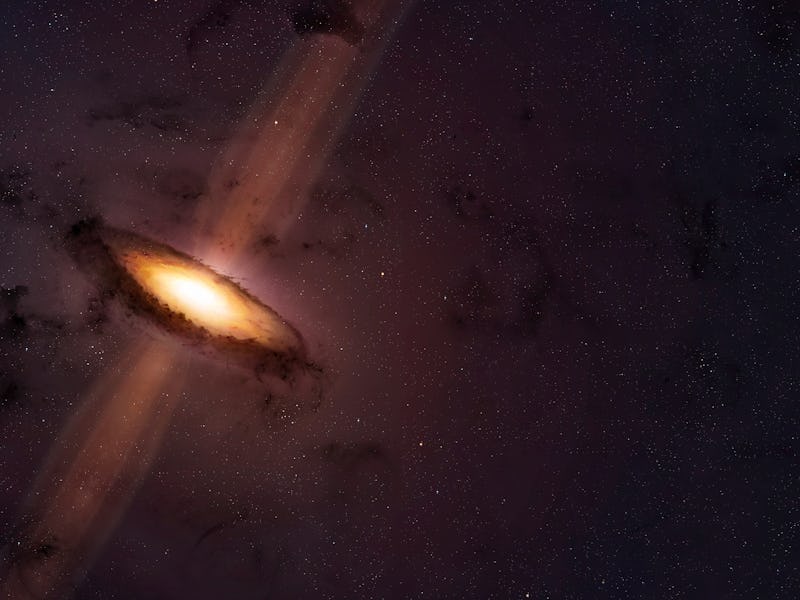Baby Neptune-like exoplanet found via a strange new astronomical technique
Just follow the breadcrumb trail ...

A new technique for discovering baby planets yields promising results, according to a new paper in the Astrophysical Journal Letters. Astronomers with the Center for Astrophysics | Harvard & Smithsonian report the detection of a unique signature of dust emission in a ring around a distant star in its infancy — evidence, they are convinced, of the presence of a baby planet about the size of Neptune.
LkCa 15 is a star 518 light years away in the constellation of Taurus. Classified as a T Tauri star (a specific category of very young star), it lies in the Taurus Molecular Cloud — sometimes described as a “stellar nursery” for its high incidence of young, recently-formed stars.
Around the young star — estimated to be between 1 million and 3 million years old — is a protoplanetary disk, which is a huge disk of rings of dust and gas particles that orbit young stars. They are believed to constitute the material from which planets form.
What’s new — In one faint ring of this disk, a team of astrophysicists used data from the Atacama Large Millimeter/submillimeter Array (ALMA) to discern patterns in the disk — clusters of increased dust trapping at two critical points, separated by 120 degrees — points which are mathematically significant for planet detection.
As Feng Long of the University of Arizona, lead author on the study, tells Inverse, “That angle really tells us that what we are finding are Lagrangian points.” Lagrangian points — positions in the orbital plane relative to a planet and its star — are critical in celestial mechanics as points of equilibrium where smaller objects (in this case clusters of dust particles) are subject to gravitational forces from both the star and its orbiting planet. In our own Solar System, Earth’s Lagrangian points are critical for satellite positioning, while Jupiter’s Lagrangian points dictate the movement of its “Trojan” asteroids.
LkCa 15 wasn’t directly imaged, but instead was found by circumstantial evidence.
The dust trapping effect in the ring around LkCa 15 — detectable with ALMA’s high-resolution continuum emission imaging — shows clusters at Lagrangian points L4 and L5 — clusters that point to a planet positioned between them in the same orbit.
“In that ring we find evidence of dust trapping — dust trapping means that all the particles are kept there because of the pressure peak,” Long says. “We have a lot of material at Lagrangian points L4 and L5, and those dust particles give us a hint where the planet should be.” Without a planet in the middle, those dust particle clusters would not be in those places.
How they did it — The technique of detecting planets with this type of imaging also means that Dr. Long can predict the size of the planet with reasonable certainty. Building on computer model simulations of likely planet–protoplanetary disk interactions, Dr. Long’s research indicates that the planet has a mass somewhere between that of Neptune and Saturn. “It’s more likely to be a low mass planet,” Long says. “If the planet is too massive, it tends to destroy those [dust] ring features.”
Compared to existing direct-imaging technology, which is only able to detect much larger planets, Long is confident that this method can help find smaller exoplanets than those currently visible.
“We can’t look at the planet because it’s very faint, but we are finding other material in the same orbit that is giving a signal,” she says. “With current technology we’re only able to detect planets over a certain mass — more massive than Jupiter — directly. With this technology, we can predict precisely where [much smaller] planets should be — given the Lagrangian points, we know it should be exactly in the middle of the two. That can facilitate future research.”
This technique would enable astronomers to detect much smaller planets than those that are currently visible through direct imaging with high-powered telescopes.
What’s next — A striking feature of this discovery is the presence of a planet in such a young star system, which complicates existing models for planet formation. Dr. Long comments, “at such an early stage we can already find so many indicators of planets there – that means that planet formation has to start early on. We still don’t know how they can build that large body in that short timescale – that’s a really challenging question.”
Observing newly-formed worlds elsewhere, possibly under wildly different conditions than our own, promises major implications for theories of star and planet formation. “Our solar system is not that typical because if you look at young star systems, their disks can be huge – they can go to a hundred, two hundred AU – so a factor of a few times bigger than our current solar system,” Dr. Long remarks, “Maybe in our solar system planets formed much farther away and then migrated inwards with hydrodynamic interactions. This is still a hot topic for our research – how different types of planets form and how they might evolve.”
This article was originally published on